I am Aubrielle Weaver, spending my summer in San Diego, California, at San Diego State University (SDSU). For six weeks I have been studying microbiology. My mentor is Gregory Burkeen, who is a Ph.D. student at SDSU. This is week 4 of my internship. I encourage you to read my previous blogs in order to understand more of what I’m doing.
On Monday a new intern from Virginia started. She is also a rising senior in high school. I’m excited to have another intern here with me. While Greg was getting her set up, I went and made my gel for my gel electrophoresis and then after the gel solidified I started the gel electrophoresis. My negative control once again came back positive, but one of my bacterias came back negative. So I don’t know what is going on at this point.
Over the weekend I left out some frozen yogurt and kefir. I centrifuged the samples and moved them into new tubes a couple of times until they were mostly chunk free. Then I streaked forward two bacterias that haven’t been streaked onto new plates in awhile. This will keep them alive. I took the liquid culture I was the most confident that it was pure and streaked it onto a plate to check. This is so I can do genome testing. It’s my best option due to the fact that my pcrs have not been doing well. I will hopefully be able to identify the bacteria with genome testing. I then made new liquid cultures for all of my alive bacteria. These will be used later on. After that I decided to make some more media, so I prepped it, put it in the autoclave, and then was able to leave because Greg pulled it out for me later that night.
The next day I had a lot that I needed to do. First I grabbed my plates and tubes from the incubator and observed their growth. One of my liquid cultures didn’t have growth. The others did. Greg needed to be able to focus on an important experiment involving a very dangerous strains of E. coli. So the new intern, Rachel, and I needed to be able to do our tasks without interrupting him. Before he got started we talked about what we needed to do and asked him all of our questions ahead of time. After, I quickly made subcultures, a liquid culture, and streaked forward a pickle plate Greg had made for me, I helped Rachel find the ingredients she needed for the media she was making. I demonstrated how to pour plates by pouring mine. And then showed her how to use the autoclave. Once my plates were done I grabbed my subcultures and made enrichments for them. I split each subculture into two different tubes then I centrifuged my frozen yogurt sample and blueberry kefir sample in small 1.5 microliter tubes. I took 600 microliters from my frozen yogurt sample and split it between the two different bacteria subcultures. Then I did the same for the kefir sample to the two remaining subcultures. Those were left in the incubator overnight.
On Wednesday I came in and grabbed my liquid cultures. Greg now thinks my mysterious fuzz is a fungus. The media for the liquid culture made the day before was a complex media with phenol red dye in it.
This is the dye that turns pink when basic, yellow when acidic, and red when neutral. The fuzz had turned pink but some of its surroundings were yellow. The bacteria that is often in milk creates an acidic surrounding which eventually kills the bacteria. Greg guessed that the fuzz is a fungus that helps keep the surroundings more neutral which helps the Kefir grains live longer. I took 900 microliters of the fuzz and put it into this special tube that is stored in the freezer. To protect the fungus from ice crystals in the freezer, I added 800 microliters of glycerol and 100 microliters of something else. Then I added it to Greg’s library. It could live in there for multiple years. So it’s pretty cool that I got to add something.
One of my other medias needed longer in the incubator, and I took a colony from the streaked forward pickle plate and put it into complex media. I also made two more subcultures for my plaque assay.
While my subcultures were growing I started a DNA extraction. I took about a milliliter from a subculture that I knew was pure and put it into a small centrifuge tube. It was centrifuged at max speed for two minutes. I dumped out the supernatant and froze the pellet. After an hour or two I took out the tube and quickly thawed it. I added 567 microliters of sterile DI (deionized) water, 30 microliters of SDS which will dissolve the cell membrane after the 3 microliters of proteinase K enzyme breaks the cell wall. This was left in a 37 degree incubator that gently shakes the samples. After an hour we took out the tube and centrifuged it. Then moved the supernatant without getting the pellet into a new tube and centrifuged again. After the last centrifuge the supernatant was moved and I started a precipitation.
To start I had to make 5 molar NaCl (Sodium Chloride/table salt). Molar is a measurement of concentration. One molar is 1 mole per 1 liter. So five molar would be five moles per liter. However I didn’t want to make a full liter. Sodium Chloride’s molecular weight is 58.44 grams per mole. So in five molar I would need 292.20 grams in one liter. I divided the 292.20 by 1000 to get the grams per milliliter and then multiplied that by ten to get grams per 10 milliliters. That was 2.922 grams. I measured 3 grams of NaCl and put it into a 15 ml tube. Then added DI water until it reached the 10 ml mark. It was heated to help the salt dissolve and gently shaken.
While the salt was dissolving my subcultures had finished. So I grabbed those and started to process my phage enrichment. Normally you would do this while the subcultures were growing but I keep forgetting to do it then. I took a mil of each enrichment and put it into 2 ml centrifuge tubes. Centrifuged them at full speed for a minute. I took 700 microliters and moved it into the filter tubes. And spun those down. Then I labeled my plates: control GK3, control CK1, plaque assay GK3, plaque assay CK1. (Gk3 and CK1 are names I have for two of my bacteria). I took 100 micros of my GK3 subculture and placed it onto one of it’s plates, and then added 1 ml of DI water to spread it on the plate until it was coated. Then it was propped open to dry. I repeated this for the rest of the plates with their respective bacterias. Once they were dry I closed the control plates and set them aside. Then I closed and flipped over my test plates to draw a line down the middle and label each side a different phage source: FY for frozen yogurt and BK for blueberry kefir. I then took 100 micros from my GK3 FY enrichment and added it to the FY side of the GK3 test plate. I then propped it to dry WITHOUT spreading it. It needs to stay on its side of the line. I then repeated this process for the respective enrichments and plate sides. Once those were dry I continued my DNA extraction.
I added 100 micros of the 5 molar salt and 1 ml of isopropanol. I centrifuged it at full speed for 10 minutes. Greg then looked at it and didn’t see a pellet like we were suppose to. I spun it again, and there was nothing. So we tried again the next day. I then moved my plaque assay plates to the incubator.
On Thursday I looked at my plaque assay plates. I might have a plaque on one of them. So to test it I need to streak it onto a bacteria lawn. The bacteria lawn is what I did with the bacteria to make my plaque assay plates. First I needed to make subcultures. I made one for my bacteria lawn and one for the enrichment I wanted to make. I hoped to make a plaque assay the next day for my GK4 bacteria. Once my subcultures were done I spread them onto plates and let them dry. Then took a micropipete, touched it to the zone of clearing on my plaque assay, and streaked it onto my test plate. The next day I had no obvious signs of a plaque.
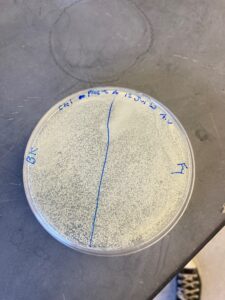
If you look closely you can see a spot of clearing close to the label on the write. This was taken after I streaked it forward so it’s a tad bit messed up.
Friday was a cleaning day. The whole lab (the room I’ve been working in plus other rooms in the building) worked together to clean from 9:30 to 11:30. I wanted to get a subculture started, so I made one for GK3 before the cleaning started. This subculture was to test another plaque I might have. I completely forgot that I wanted to make a subculture for GK4 to do a plaque assay. So I will do that Monday. Once the subculture was in the incubator, Greg took Rachel and I to another room to help clean. I washed some tube holders which took me a little over an hour. But it went quickly. And once I was done Greg took us back to his lab room and we got started on our work for the day. I wanted to do a DNA extraction. While I heated the SDS again so that it would be a solution, I ate lunch with Rachel in this fern garden outside of the north life sciences building. When we came back I autoclaved some tubes that I used for old liquid cultures, streaked plates to keep bacteria alive during the weekend, made new liquid cultures, and tested to see if I had a phage on my other plaque assay. and then continued with my DNA extraction. We tried multiple different ways but finally a freeze and thaw method worked. We would put the tubes with our bacteria on dry ice until frozen then put it into this heater thing until thawed and repeated 3 times. Eventually we got our cells broken apart and had DNA.
So we centrifuged And washed it out so the salts wouldn’t be there anymore. And then we will do a concentration test on Monday.
Friday night I went to this dessert shop called MNGO cafe.
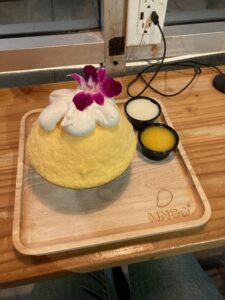
Isn’t it soooo beautiful? The cream on top was my favorite. The flower was edible but didn’t taste good.
I had this delicious Japanese shaved ice. It was beautiful and delicious. Then the next day I went to the beach for a sunrise swim but it was too cloudy. I also saw stingrays in the water so quickly got out. I got myself a build a bear as a souvenir and got some saltwater taffy.
For dinner I went to this amazing ramen place. (cover photo is the ramen) They only gave you chopsticks and a spoon-like scoop. So it was a struggle for me to figure out how to eat it. I gained chopstick skill though. Then on Sunday I went out for breakfast. Looking forward to this next week at work!

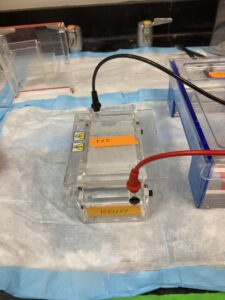
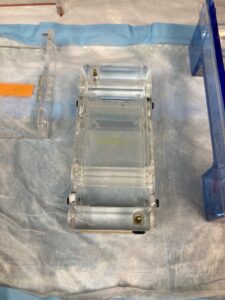
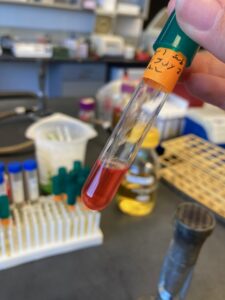
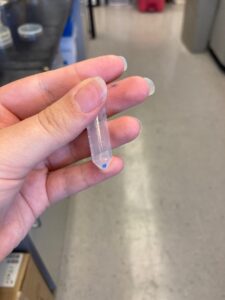
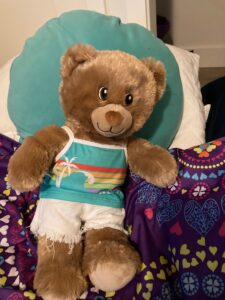
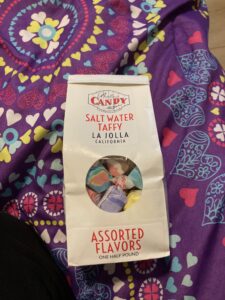
Aubrielle, wow! You have been learning and doing so much during your pinternship, I love to see it!